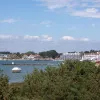As much as anything else, Purbeck and the little sandy spit on which the motor road exists are beautiful places, and a few pictures of them wouldn't go amiss on any website. But the Studland Motor Road is such an odd beast that it's worth seeing just how unassuming this little legal anomaly is to appreciate what makes it so unusual.
From Godlingston Heath, Poole Harbour is visible in its entirety. From here the narrow channel where the ferry operates is visible, with Bournemouth behind it and the grassy sand dunes hiding the motor road in the foreground.
Studland is a sleepy little village, a dead end until the mid 1920s, and it still has the feel of being at the end of the line. It's not the sort of place you expect a motorway to terminate!
A cluster of signs inhabit the traffic island where Swanage Road ends. Beyond this junction, Ferry Road is owned by the ferry company.
Here it is - the motor road. It is laid out in the manner of a 1920s new road, with long straights connected by brief corners, and has two lanes throughout. You can park on it, or walk, or cycle if you like.
The surrounding landscape is mainly sand dunes, many of them covered in grass or scrub. The ferry company has not exercised its right to fence the road in, and so you can walk to the beaches very easily.
Towards the end of the section that is open without charge, warning signs indicate that the free ride is about to stop. Shortly afterwards parking restrictions begin.
The roundabout and toll plaza here were installed in the early 1990s in preparation for the new, larger ferry that was introduced in 1994. The roundabout provides access to a National Trust car park to the right.
From the top of the dunes, the slipway on the opposite shore is visible, sticking out from the thickly wooded shores of Sandbanks.
Here on the south shore, the motor road literally turns into the slipway, betraying the fact that it was built to access this ferry and nothing more.
Between the toll plaza and slipway, the road is fenced and bordered by these chains, which presumably did several decades of service under the water before finding a new role as kerbing.











